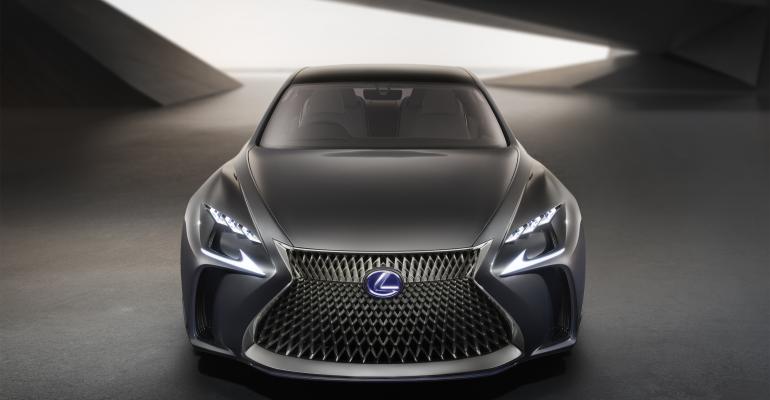Many have wondered what Lexus would do to reinvigorate its aging LS flagship sedan, given the advanced nature of the Mercedes-Benz S-Class and BMW 7-Series, the former with semi-autonomous driving technology and the latter with hand-gesture controls.
The concept LF-FC, a hint at the fifth-gen ’17 LS unveiled today at the 2015 Tokyo Motor Show, has those technologies too, but also is fitted with a hydrogen-fuel-cell system.
“The high output fuel cell power system energizes the rear wheels and also sends power to two in-wheel motors in the front, making the LF-FC all-wheel-drive,” Lexus says in a statement, giving no range, fuel-economy or performance figures for the car.
Mercedes earlier this year introduced the autonomous F015 plug-in fuel-cell sedan making 272 total horsepower and roughly 684 miles (1,101 km) of range. Today at the Tokyo show the German automaker debuts the Vision Tokyo, a plug-in fuel-cell MPV with a range of 609 miles (980 km).
Lexus says the fuel-cell stack in the LF-FC is strategically located in the rear of the vehicle, while the power-control unit is in the front and hydrogen fuel tanks are configured in a T-formation.
Up to now, the LS has been more of a comfort cruiser, but it appears Lexus is trying to up the car’s athletic credentials, noting the above layout results in optimal front and rear weight distribution for what it calls a sport sedan.
Lexus also says the LF-FC fuel-cell system precisely distributes torque between the front and rear wheels for “exceptional dynamic handling and superior road stability” and that its coupe roofline suggests a vehicle not just for straight highways but twisty roads, too.
The automated technology in the LF-FC includes prediction and judgment functions, as well as elevated levels of traffic-environment recognition, Lexus says.
Hand gestures used to control the audio and ventilation functions of the car can be interpreted near a small holographic image on the center console.
In keeping with Lexus’ push to shed its stodgy image, the LF-FC, like most recent concept and production Lexuses, has more daring sheet metal.
Lexus calls the LF-FC’s look an updated version of its L-finesse design language, with an “evolved” spindle grille with a new mesh design.
Other design cues include L-shaped daytime running lights and taillights that appear to float, as well as 21-in. aluminum wheels with carbon-fiber-reinforced plastic rims, the luxury marque says.
The floating theme continues inside the car, as front seats are claimed to float at eye level.
The LF-FC’s cockpit is meant to convey a sense of openness, allowing the driver to concentrate on the road and rear-seat passengers to relax and recline.
The LF-FC shown in Tokyo appears to be a long-wheelbase version, given its 209-in. (5,300-mm) length, roughly 5 ins. (127 mm) longer than the current-gen LS 600h L, the hybrid and LWB version of the car.
The LF-FC also is 79 ins. (2,000 mm) wide and 56 ins. (1,410 mm) tall, roughly 5 ins. wider but 2 ins. (51 mm) shorter in height than the ’15 LS 600h L.
Lexus doesn’t say if the fuel-cell technology will make it into the production LS, but the brand’s most recent concepts have been relatively close to production. Also, the high-priced nature of fuel-cell technology is a good fit for the flagship LS, which today begins at $75,520 and reaches $120,440 for the LS 600h L.
Lexus has been eagerly anticipating a new LS, given the declining sales of the current model this year.
LS sales in the U.S. through September fell 10.7% to 5,270 units, a fraction of the segment-leading Tesla Model S’s 17,291 deliveries in the period.
The LS is mid pack in WardsAuto’s Upper Luxury Car segment, outselling the Audi A8, Jaguar XJ and Porsche Panamera, but not faring as well as the Audi A7 and BMW 7-Series.





